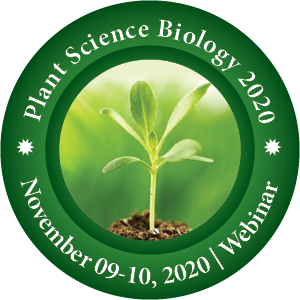Plantsciencebiology-2021
ABOUT CONFERENCE
Market Analysis
Sessions and Tracks
Track: 01
Ecotourism And Environmental Ecology
Ecotourism deals with interaction with biotic components of the natural environments and focuses on socially responsible travel, personal growth, and environmental sustainability. Ecotourism typically involves travel to destinations where flora, fauna, and cultural heritage are the primary attractions and it is intended to offer tourists an insight into the impact of human beings on the environment and to foster a greater appreciation of our natural habitats.Environmental Ecology
Environmental ecology is the branch of biology which studies the interactions among organisms and their environment. Objects of study include interactions of organisms with each other and with abiotic components of their environment. It includes the study of plants and animals populations, plants, and animals community as well as the ecosystems.
Track: 02
Plant Functional Genomics , Biotechnology and Bioremediation
Utilitarian Genomics has been built up to examine the structure and capacity of atomic genome in higher plants. The improvement and utilize biotechnology and genomic instruments in financially vital plant species, for example, timberland and natural product species, grains, vegetables and therapeutic plants. Actual activities are harmonized to explore genomic tools, meant for sample, sequencing, transcriptomics, proteomics, and atomic markers, to differentiate supervisors, potentials and structures in regulator of protection from vermin, ailments and for resilience to water shortfall, saltiness and temperature push. Stranded by functioning, normal interaction and biotechnology campaigns, we recognize new plant items, enhance biomass creation, and furthermore bolster reproducing programs. The investigation of bioactive mixes and potential wellbeing valuable impacts of sustenance metabolites is additionally performed.
- Cereal Genomics
- Plant Science Meeting
- Plant genomics scope in Europe
- Micro propagation in Plants
- Plant Tissue Culture and Biotechnology
- Sequencing
- Transcriptomics
- Proteomics
- Molecular marker development / Marker assisted selection
- Drought Tolerance and Frost Tolerance
- Heat Tolerance
- Hybrid wheat and Phenotyping
- Plant Science Meeting, Paris, Plant Biology Conferences
- Plant Transformation
- Salinity Tolerance
- Structural Biology
- Plant Genomic Case Studies
Bioremediation is a process used to treat contaminated media, including water, soil and subsurface material, by altering environmental conditions to stimulate growth of microorganisms and degrade the target pollutants. In many cases, bioremediation is less expensive and more sustainable than other remediation alternatives. Biological treatment is a similar approach used to treat wastes including wastewater, industrial waste and solid waste.
Track: 03
Geographical And Earth Sciences
The science of geography has three main branches: Physical geography is the study of Earth, its physical features, landforms, weather, soils, oceans, water, and attributes such as size and shape, both in the present and the past. Human geography is the study of people and their distribution, particularly with respect to culture, religion, politics, economics, health, demographics, and other characteristics. Environmental geography examines how people interact with the environment in relation to the space they occupy. Each branch overlaps the others in some ways, but differs in the kinds of questions it seeks to answer and in the focus of its work.
Track: 04
Plant Science And Natural Products
Transgenes appear to be particularly sensitive to epigenetic variation which can lead to transgene silencing, i.e. the complete or partial inactivation of transgene expression. Plants are ideal model systems to study the influence of changing environmental conditions on epigenetic patterns. We are especially interested to understand how certain genomic regions become targets for epigenetic modification and how environmental stress affects epigenetic gene regulation. Our applied work investigates how transgene silencing can be prevented and how epigenetic variation can be exploited for novel breeding strategies.
- Plant Protection
- Extracting ingredients for cosmetics using green technologies
- Sustainable business practices
- Natural replacements for petrochemical ingredients
- Chitosan as a basic for personal care products
- Plant Neurobiology
Track: 05
Agro-Ecological Production System
Agroecology shares much in common with other approaches to sustainable farming. Agroecology is farming that “centers on food production that makes the best use of nature’s goods and services while not damaging these resources.” Farming thrives when it works with local ecosystems, for example, improving soil and plant quality through available biomass and biodiversity, rather than battling nature with chemical inputs. Agroecological farmers seeks to improve food yields for balanced nutrition, strengthen fair markets for their produce, enhance healthy ecosystems, and build on ancestral knowledge and customs.*
Promoters of agroecology strive to nurture a healthy landscape in which to grow the world’s food and fiber. They are guided by an ethos of bio and cultural diversity featuring small farmer-centered applied research and policies that protect their livelihoods. Worldwide, scientists, grassroots organizations, NGOs, consumers, universities, and public agencies are working with farmers to construct sustainable and nutritious food systems based in agroecology.
Track: 06
Medicinal And Aromatic Plant Sciences
The importance of plants has been concluded by scholars since ancient period. Apart from the innumerable social benefits, much strength has been given to the plants of medicinal value. Majority of the population in developing countries assume on traditional system of medicine for their primary health care. Due to this increasing trend towards use of different system of medicine, natural medicinal plant resource in this world is under enormous pressure. Several Institution/ Organization/ Universities and Industries across the world have been steady in research and documentation of various conditions of these medicinal plants to frame a system for their preserving. In this way numerous research papers on each medicinal plant covering vast subject areas like Botany, Chemistry, Pharmacology, Pharmacy etc. are available. This will help the scientific community to keep themselves restore with the research and development work being implemented for a medicinal plant. This researcher will also be a source of favorable information for students, teachers, practitioners all those who are involved in their propagation etc.
· Ornamental plants and bioactive compounds
· Olive Bioactive: Applications and Prospects
· Phytochemistry Experts Meeting
· Drug discovery from natural sources and Herbal Medicines
· Natural products in plant medicine
· Microbiology and Phycology
Track 07:
Phytotomy is the general term for the study of the internal structure of plants. Originally it included plant morphology, the description of the physical form and external structure of plants. Plants are the living, multicellular, being an organism that belongs to the dominion Plantae. There square measure over 3000,000 species of plants. Plants play a key role within the history of life on planet earth. Plants are the most accountable for the addition of element gas to the atmosphere. they are the sole supply of food for both animals and humans. They are the primary environment for many alternative organisms. A plant resides that turn out their food by chemical process. Plants provide shelter, safety, place, food for animals.
- Primary growth of plant
- Comparative Morphology
- Adventitious Root Formation
- Plant Nutrition and Soil Sciences
Track: 08
Biodiversity And Evolution Of Plants
Humankind has affected our planet in many ways. In the past few centuries the changes in society and the "Biodiversity" is the full complexity and variety of life, at all scales, from genetic diversity, up to species and even ecosystem diversity. So, we use the term "biodiversity conservation" to refer to attempts to conserve and any parts of this natural diversity. Plant diversity is a major plant of total biodiversity - just think of the richness of tropical rain forests -.it forms the basis of all food webs and underpins the functioning of all ecosystems. So, plant conservation is an essential component of efforts for biodiversity conservation. As plants are at risk of extinction, in all parts of the world, their conservation is a priority.
- Plant Ecology
- Biodiversity and Environmental Sciences
- Development and Economical Agribusiness
- Plant Biochemistry and Bio systems
Track: 09
Plant Tissue Culture And Diseases
Plant tissue culture is the strategy of developing and keeping up plant cells, tissues or organs particularly on simulated medium in appropriate holders under controlled ecological conditions. Any piece of a plant is taken out which is known as explant and developed in a test tube under sterile conditions.
Cell division from explant frames callus which can be developed into another new plant. Plantlets can be recovered by tissue refined which includes different strategies, for example, immunization, hatching, recovery and solidifying. Transgenic plants can likewise be built by tissue refined methods. Micro propagation is an incorporated procedure which likewise includes in recovery of plants by different techniques, for example, Multiplication by Adventitious Shoots, Axillary Buds and Apical Shoots, Multiplication Through Callus Culture, Organogenesis and Somatic Embryogenesis.
- Micro propagation in plants
- Applications of Plant Tissue Culture
- Callus and suspension Culture
- Embryo Culture
- Regeneration of Plantlets
- Somatic Hybridization
- Resistance to weedicides
Track: 10
Plant Nutritious Genomics recoils a summary of plant appropriate genomics, which remains categorized as the relationship between a plant's genome and its motivating possessions. The astute assurance and rising of varieties of items will accept a gigantic part in meeting these objectives, and advances in plant healthy genomics will allow the greatest limit of yield decision and repeating systems to be made sense of it. Understanding plant sustenance and applying this learning is critical to growing product age to meet creating demands for sustenance. Genotypic approaches, in perspective of collect assurance and recreating have starting late benefit by mechanical advances, including the satisfaction of plant genome sequencing wanders.
- Green nanotechnology
- Agriculture Nano toxicology
- Uptake and Translocation of Nanoparticles in plants
- Effects of Nanoparticles on plant growth and development
- Transgenic plants producing vaccines
- Vaccines given to plants for a healthy vegetation
- Plant Neurobiology
Track: 11
The notion that medicines derived from plants rely for his or her action on active principles gift has got to be changed visible of the findings that there square measure, in several cases, adjuvant substances within the plant that enhance the activity of the elements really answerable for the result. This natural action might involve protection of a lively substance from degradation by enzymes, it's going to facilitate transport across barriers like cell and cell organ walls, it's going to overcome multi-drug resistance mechanisms or give alternative signals to the hosts cells that lead to higher efficaciousness of the crude drug when put next with isolated elements. the numerous plant substances that stimulate the system, typically at terribly low doses, haven't been reviewed as this is often not properly speaking natural action. a number of the proof for the phenomena delineate is reviewed and its touching on herbal therapy commented.
Track: 12
Plant Physiology And Hydrology
Plant physiology
It serves as the foundation for the numerous advances in forestry, agronomy, floriculture, plant pathology. Plant physiology is a science of how plants develop, grow & respond to their environment at the cellular and biochemical level. Plant Physiology Is the study of plant structure and function, leaf anatomy, root anatomy, and fundamental process such as Photosynthesis, respiration, plant nutrition, plant hormone functions, nastic movements, seed germination, dormancy, and stomata function and transpiration, water and sugar conductivity and the reproductive organs of plant.
· Biotic and Abiotic stress in plants
· Photo- morphogenesis & Photo-periodism
· Plant hormones & Nutrition
· Molecular Plant breeding and experimental Plant Breeding
· Plant Glycobiology
· Microbiology and Phycology
Hydrology
Water is an essential resource that is required by all life on Earth. Studying the movement, availability, and quality of water are the jobs of a hydrologist. More specifically hydrologists study the chemical properties, biological interactions, and the physical processes that govern the water cycle.
The water cycle or hydrologic cycle is a process by which water is continuously cycled around the earth. This happens through different pathways and at different rates but the central concepts remain the same. Water evaporates from the ocean, condenses as clouds, moves over land, and precipitates. From there it can enter ground water, evaporate again, or enter a stream or lake. It will eventually find its way back to the ocean either by falling as precipitation, flowing with a river, or by moving ever so slowly with ground water. The hydrologic cycle is also a process that transfers heat energy. Heat is transported pole ward by water being evaporated and then condensing which releases heat. Without the water cycle the climate would be much more frigid and areas away from the equator would be much less habitable
Track: 13
Endocrinology & Metabolism Of Plants
Plant metabolism is defined as the complex of chemical and physical events of respiration, photosynthesis, and the synthesis and degradation of organic compounds. These metabolic pathways allow the organism to perform all the normal life processes such as growth and maintenance of cell structures, repair damage, reproduction and respond to environment. The enzymatic activity of plants is controlled by allosteric sites by which modulator or effectors binds to it. Biosynthesis of enzyme protein is done by translation and translocation level. Crassulacean (CAM) is a carbon fixation pathway exists in succulents such as cacti and other desert plants as an adaptation to arid conditions.
- Plastid Metabolite Transporters
- Photosynthesis
- Light Reactions
- Oxidation-Reduction Reactions
Track: 14
Plant Biotechnology And Bio-Energy Production
Plant biotechnology is also known as the green biotechnology and is defined as the introduction of the desirable traits in plants by the using technique genetic modification and it is used for the enhancement of agriculture and food quality. Biotechnology is mainly for improvement of varieties and for fruit ripening delay and for ornamental plants development and for biodiversity protection. Plant biotechnology is the incorporated use of biochemistry and micro biology to achieve the capabilities of microorganisms and cultured tissue cells. plant tissue culture is easiest and widely accepted biotechnology system. It entails the culture of plant leaves, roots, petioles, stems, fluorescence in artificial media under the aseptic conditions.
· Plant Genome Engineering and Plant genetic diversity
· Improving gene editing technology, enzymes, and methods
· Genome editing applications using new techniques
· Genome editing and the latest EU policies
· Genome / DNA assembly for editing
· Plant Genetic Engineering and GM crops
· Plant Gene Editing for the Consumer
· Plant engineering and its Applications in Cereals
· Plant Biochemistry and Bio systems
Bioenergy
Bioenergy is one of many diverse resources available to help meet our demand for energy. It is a form of renewable energy that is derived from recently living organic materials known as biomass, which can be used to produce transportation fuels, heat, electricity, and products. Abundant and renewable bioenergy can contribute to a more secure, sustainable, and economically sound future by:
· Supplying domestic clean energy sources
· Reducing U.S. dependence on foreign oil
· Generating U.S. jobs
· Revitalizing rural economies.
Track: 15
Plant pathology is the study of the environmental conditions and the organisms that which cause diseases in plants and the effects on plant growth and controlling plant diseases methods it also deals with the microbiology and mycology, virology, etc. Plant diseases are varying from season to season, depending on the pathogen and environmental conditions controlling of plant diseases is crucial for production of food and it is achieved by the selecting desirable plants which are more resistant to many diseases and by using the pesticides. Mycology is defined as the study of fungi, and their dangers and study of fungal genetic and biochemical properties, and their uses.
· Insect Plant Interactions
· Microbial Genomics
· Plant Environment Interaction
· Fungal Plant Interaction
· Nutrition Improvement
· Plant Immune Response
· Microbiology and Phycology
Track: 16
Agriculture And Natural Resources
Agriculture is the cultivation of plants for food, fuel, medicinal plants and other products useful to the human life. And it is the practicing of farming, cultivation of the soil for growing crops. the ecosystem services that are responsible for human life on this planet. Agronomy is one technology of producing plants for the food and fuel, agronomy is use-full method for creating healthier food. Natural resources are resources that exist naturally without actions of humankind. Natural resources include crops, sunlight, vegetation, water, etc. natural resources are divided in to different types. Natural resources are materials that can be used found in the environment.
· Modern technologies for Vegetation
· Agricultural Meteorology
· Seasons and Systems of Farming
· Irrigation and Water Management
· Harvesting and Post-harvest Technology
· Agronomy of Field Crops and Biofuel Plants
· Plant and Environment
Track: 17
Forestry And Post-Harvest Technology
Forest is a complex of ecosystem consisting of trees. Forestry is the science of conserving & repairing of forests to meet desired needs for human benefits. Forestry science belongs to the biological, physical sciences. Forests are nature’s power house. Disappearance of forests leads changing rainfall pattern. Forestry is important because 25 percent of the drugs are derived from the trees & industrial oils and resins, dyes are yields from the trees. Medical plants gum provided by forests. It is also widely used for medicines. They deserve much greater attention than they are getting now.
· Forest Resources Management
· Forest and Conservation Sciences
· Wood Science
· Forestry and Nature Conservation
· Geography and Geomatics
Track: 18
Food Production And Horticulture
Horticulture is the branch of agriculture deals with the cultivation of the fruits, vegetables and the ornamental plants. Horticulture mainly divided in to different branches. Pomology it deals with the cultivation of the fruit crops. Olericulture it deals with the cultivation of the vegetable plants. Floriculture it deals with the cultivation of the ornamental flowers. Fruit & vegetable preservation it deals with the principles of fruit and vegetable preservation.
· Floriculture Management
· Greenhouse Management
· Plant Nursery Operations
· Ornamental Horticulture
· Turf Management
· Plant and Environment
Track: 19
Plant-Weed Interactions And Management
Weeds and native plants should be considered when endeavouring to manage and control plant pathogens of cultivated plants. Whether as a pest itself, vector of a pathogen, or reservoir of a pathogen or its vector, weeds can significantly influence disease incidence. The relationship between these factors plays a critical role in determining disease incidence and impact. Weeds can interact with pathogen management in several ways, including provision of weed biological control, parasitic weeds can directly serve as vectors of plant pathogens, weeds can serve as reservoir alternative hosts for pathogens and vectors, weeds may be obligate alternate hosts for some pathogens, and herbicides used for weed control can interact with plant pathogens
Track: 20
Phylogeography, and its extensions into comparative phylogeography, have their roots in the layering of gene trees across geography, a paradigm that was greatly facilitated by the nonrecombining, fast evolution provided by animal mtDNA. As phylogeography moves into the era of next-generation sequencing, the specter of reticulation at several levels—within loci and genomes in the form of recombination and across populations and species in the form of introgression—has raised its head with a prominence even greater than glimpsed during the nuclear gene PCR era. Here we explore the theme of reticulation in comparative phylogeography, speciation analysis, and phylogenomics, and ask how the centrality of gene trees has fared in the next-generation era.
Track: 21
Plant Cytogenetics And Cytology
Cytological and cytogenetic data as evidence of value in taxonomic decision-making and biosystematic investigations over the past 50 years is surveyed. The main headings considered are chromosome number, genome size, chromosome morphology, chromosome staining characteristics, chromosome and genome disposition in the cell, and chromosome behaviour and homology. The main conclusions are that many of the exciting new developments at the borders of cytogenetics and molecular biology (molecular cytogenetics) are producing a wealth of new data of enormous taxonomic and evolutionary importance, but that for these to reach their full impact it is essential that they are fully integrated with traditional cytological data, the need for which remains as great as ever.
Track: 22
Plant Based Bio-Fuels, Bio-Gas And Bio-Energy
Biomass can be converted directly into liquid fuels, called "biofuels," It is a fuel that is produced through contemporary processes from biomass, rather than a fuel produced by the very slow geological processes involved in the formation of fossil fuels, such as oil. There are various ways of making biofuels, but they generally use chemical reactions, fermentation, and heat to break down the starches, sugars, and other molecules in plants. The resulting products are then refined to produce a fuel that cars or other vehicles can use.
Biomass is fuel that is developed from organic materials, a renewable and sustainable source of energy used to create electricity or other forms of power. Some examples of materials that make up biomass fuels are:
- scrap lumber
- forest debris
- certain crops
- manure and
- some types of waste residues.
Biomass is a renewable source of fuel to produce energy because waste residues will always exist – in terms of scrap wood, mill residuals and forest resources; and properly managed forests will always have more trees, and we will always have crops and the residual biological matter from those crops.
Track: 23
Plant Synthetic Biology And Plant Transcriptome
Synthetic biology is an approach to engineering science. The stabilization of element, from screw threads to printed circuit boards, drives both the speed of innovation and the economy of production in mechanical and electronic engineering. This conceptual model is the basis of synthetic biology, where the principles of engineering are applied to biological systems. Synthetic biology is not what we are making; Developing tools and methods for the precise modification of plant genomes and establishing a standard structure for collection of plant genes.
- enabling plant synthetic biology through genome engineering
- plant transcriptome analysis
- plant disease Transcriptome
Track: 24
Grasslands and Rangelands: Tens of thousands of farmers and ranchers depend upon the health of rangelands and grasslands for his or her livelihoods. Rangelands include a large sort of landscapes, as well as some grasslands, shrublands, wetlands, tundra, and deserts. autochthonic to each continent except continent, grasslands’ immense expanse is dominated by grasses and non-woody plants. Rangelands, primarily lined by natural vegetation, offer grazing and forage for stock and life. The fertile soil that characterizes several grasslands create the areas similar temperament to cultivating crops.
Past Conferences Report
PAST CONFERENCE REPORT
5th Annual Congress on Plant & Soil Science scheduled February 28- March 01, 2019 London, UK with the support and contribution of the Organizing Committee Members, we successfully hosted the event at the conference venue.
Firstly we must thank you for trusting us and participating at Plant Science 2019, a global platform to discuss various important aspects of Plant and soil science.
There are infinite reasons to extend our gratitude to you for making the Plant science 2019 outstanding conference. We couldn't have done it without your continuous support and believe towards our organization, which mutually made to achieve Plant and soil science 2019 new height in the field of Agriculture.
The conference was marked by the attendance of young and brilliant researchers, business delegates and talented student communities representing more than 30 countries, who have driven this event into the path of success.
The conference was organized around the theme “State of Plant and Soil Research & the Emerging Applications”. The event implanted a firm relation of upcoming strategies in the field of Infectious with the scientific community.
The conference proceedings were carried out through various Scientific-sessions and plenary lectures, of which the following Speakers were highlighted as The conference witnessed an amalgamation of peerless speakers, Keynote speakers, well-known researchers and delegates who enlightened the crowd with their enviable research knowledge and on various alluring topics related to the field of Infectious Diseases through their fabulous presentations at the podium of Plant and soil science.
EuroSciCon Ltd offers its heartfelt appreciation to all the Organizing Committee Members, Chairs and Co-chairs, Speakers, Students, Media Partners and Editorial Board Members of Journal of Soil science and Plant health, Journal of Pathology and plant physiology who supported the conference in every aspect for the awe-inspiring exhibition at the venue.
We are also obliged to various delegate experts, company representatives and other eminent personalities who supported the conference by facilitating active discussion forums. So, as continuation of Plant science 2020,We would like to heartily invite you to our upcoming 6th Annual Congress on Plant Science and Biology June 19-20, 2021 London, Uk. We look forward to seeing your benign presence with active contribution and support to make this event successful once more.











































